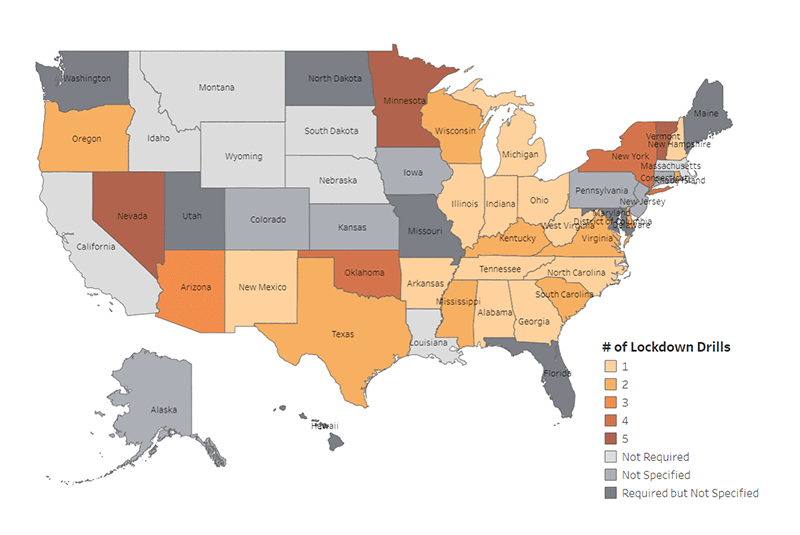As students and staff return to schools across the country this fall, there will be renewed focus on safety and security. Among the topics of conversation will be lockdown drills, which are part of the comprehensive efforts of schools to prepare students and staff for a range of emergencies, including human-caused and natural disasters (e.g., fire, tornado, earthquake), that their building may face. Although often discussed synonymously with active shooter protocols, which typically reference options-based procedures, such as Run Hide Fight, that are specifically designed for armed assailants, lockdown drills can be used for any active threat inside of the school. This can include active shooters but also may involve other types of criminal activity, dangerous animals, and other possible threats that enter the building.
The purpose of the lockdown procedure during an emergency is to build time and distance between the threat and the school building’s occupants. This is accomplished by securing doors to classrooms and offices, turning off the lights in the space,1 moving out of sight of any interior corridor windows, and remaining silent for the duration of the lockdown. Occupants should not respond to any knocks at their door or attempts by individuals outside of the room to gain entry once they have completed the lockdown. The first step of the procedure—locking the door—has been highlighted by scholars and school shooting review commissions alike as being the most important to keeping students and staff safe during an active threat event inside the school building.
Recent research by Regional Gun Violence Research Consortium members Jaclyn Schildkraut, Amanda Nickerson, and Emily Greene-Colozzi found that the use of lockdowns during real-world mass shootings in schools has a protective effect, resulting in 59 percent fewer total casualties (injuries and fatalities). When considering fatalities only, lockdowns lead to 79 percent fewer victims pronounced dead on scene and 63 percent fewer deaths overall. Notably, this same research found that lockdowns also have a protective effect during mass shootings occurring outside of schools.
Drills for lockdowns, as well as preparedness drills for fires, tornadoes, and earthquakes, provide opportunities for students and staff to practice steps of a particular procedure in a controlled environment. This helps individuals develop muscle memory, or the ability to perform a certain action or series of steps, like a lockdown procedure, without conscious effort as their thinking may be impaired by stress. At the same time, consistently conducting drills—and combining such efforts with training on the school’s response protocol—can allow administrators and safety teams to identify potential improvement areas, implement solutions to address any issues, and assess future drills to ensure that any concerns have been remedied.
… the use of lockdowns during real-world mass shootings in schools has a protective effect, resulting in 59 percent fewer total casualties (injuries and fatalities). When considering fatalities only, lockdowns lead to 79 percent fewer victims pronounced dead on scene and 63 percent fewer deaths overall.
During the 2019-2020 school year, approximately 98 percent of public K-12 schools conducted lockdown drills with students and staff. Moreover, as of June 2022, more than 96 percent of public schools in the United States had written plans for active shooter response. While the steps of the lockdown drill are often similar, there is variability in state requirements for the number and types of drills that should be conducted. These differences can also trickle down to the district and even school level as different protocols are employed.
To help policymakers and the public understand the landscape of lockdown and other emergency preparedness drills in the United States, the Regional Gun Violence Research Consortium has launched a new resource, the School Lockdown Drill Dashboard. This resource was developed by our research team as part of our work on lockdown drills. Building upon the Education Commission of the States’ comprehensive list of school safety policies, we then reviewed all states’ individual laws and policies available through their respective departments of education to ensure the most current information is included.
As the debate around lockdown drills and school safety more broadly continues, it is imperative for policymakers, school administrators, and other vested stakeholders to ensure that efforts made to keep students and staff safe follow the evidence. This dashboard and other evidence-based resources should be consulted to guide efforts and ensure that schools are safe, healthy, and productive learning environments.
ABOUT THE AUTHORS
Jaclyn Schildkraut is executive director of the Regional Gun Violence Research Consortium (RGVRC) at the Rockefeller Institute of Government
Amanda B. Nickerson is professor of school psychology and director of the Alberti Center for Bullying Abuse Prevention at the University at Buffalo, State University of New York, as well as a member of the RGVRC
Hannah Grossman is a doctoral student in the Counseling Psychology/School Psychology Program at the University at Buffalo
[1] The step of turning off the lights, as well as potentially covering classroom windows, can vary by jurisdiction. School administrations should consult with local law enforcement and state guidance about these steps.

